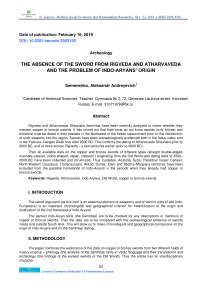The Absence of the Sword from Rigveda and Atharvaveda and the Problem of Indo-Aryans Origin
Автор: Semenenko Aleksandr Andreyevich
Журнал: Bulletin Social-Economic and Humanitarian Research @bulletensocial
Статья в выпуске: 1 (3), 2019 года.
Бесплатный доступ
Rigveda and Atharvaveda Shaunaka Samhitas have been carefully analyzed to check whether they mention copper or bronze swords. It has turned out that both texts do not know swords (only knives) and therefore must be dated in their habitats in the Northwest of the Indian subcontinent prior to the introduction of such weapons into the region. Swords have been archaeologically evidenced both in the Indus valley and in the YamunaGanges Doab only after 2000 BC. This confirms the dating of Atharvaveda Shaunaka prior to 2000 BC, and of more archaic Rigveda a few centuries earlier (prior to 2600 BC).Then all available data on the copper and bronze swords of different types (straight double-edged, machetecleaver, sickle-shaped, rapier, harpoon) originating from the Old World and dating back to 3500 2000 BC have been collected and scrutinized. Thus Cyclades, Anatolia, Syria, Palestine/ Israel/ Canaan, North-Western Caucasus, Transcaucasia, Akkad, Sumer, Elam and BactriaMargiana territories have been excluded from the possible homelands of Indo-Aryans in the periods when they already had copper or bronze swords.
Rigveda, Atharvaveda, Indo-Aryans, Old World, copper or bronze swords
Короткий адрес: https://sciup.org/14114679
IDR: 14114679 | DOI: 10.5281/zenodo.2563192
Текст научной статьи The Absence of the Sword from Rigveda and Atharvaveda and the Problem of Indo-Aryans Origin
The sword argument (as this item is an essential element of weaponry and of warrior cults of late IndoEuropeans) is an important chronological and geographical criterion for indentification of the origin and localization of the first homeland of Indo-Aryans.
The earliest Indo-Aryan texts (the Samhitas) are to be checked for any descriptions or mentions of copper or bronze swords. Then the data are to be compared with the archaeological evidence of swords inside and outside South Asia. This will allow us to make chronological and geographical conclusions on the origin of Indo-Aryans and on the Samhitas‘ dating.
II. METHODOLOGY
The paper combines the exploration of the data on copper or bronze swords from two different fields of history science – philology (the analysis of the Samhitas‘ texts in Vedic language and their translations) and archeology (the findings of the earliest swords of the Old World). Thus the article has an interdisciplinary character.
i«
III. DISCUSSION
It is crucial for the correct understanding of Indo-Aryans‘ origin and its dating to get the exact translation and interpretation of the Rigveda and Atharvaveda Samhitas (further RV and AVSh). That‘s why we have used not only the texts of the Vedic hymns themselves but also several most competent translations of them into different languages – Russian, German and English. Not only the terms designating sword‘ have been taken into consideration but also the words usually translated as knife‘ or dagger‘ or blade‘ and even axe‘ have been scrutinized thoroughly to exclude possible misreading and mistranslating. Thus the results of the textual analysis received are of a high degree of reliability.
There are various opinions among scholars as for the length of the real‘ sword. Several authors state it is a matter of a personal choice. We agree with the scholars who state that a sword can be defined as a true‘ sword if the lenghth of its blade itself exceeds 30 cm at least (in case of a short sword).
IV. RESULTS
The texts of RV and AVSh have been thoroughly studied by us (alongside with the translations of both Samhitas by T. Ya. Elizarenkova and of RV by H. Grassmann, F. M. Müller, K. F. Geldner and S. W. Jamison and J. P. Brereton) to find out whether they contain any mentions of the copper or bronze swords. The result is negative — sword made of copper or bronze is not known to the authors of the Rigvedic and Atharvavedic hymns.
This facts leads to two conclusions — the first is chronological and the second is geographical. As for chronology RV and AVSh must have been composed in their habitat in the Northwest of South Asia prior to appearance of copper and bronze swords in this region.
The creators of the Mature Harappan civilization in the Indus valley were familiar with swords at least from the beginning of the II millennium BCE. At Mohenjodaro two swords cast in copper were excavated (one in the layer dated between 2000–1900 BC). They have total length of about 47 cm and 37 cm respectively (the second‘s tip is broken off). Both have tangs and holes for fixing the hilt. Both have a middle rib for strengthening the blade and shoulders. Also a piece of a sword blade cast in copper was found. It has a length of 8.13 cm and a middle rib. The photographs of the swords can be seen in the digital collection of the National Museum in New Delhi (Figures 1, 2).

Figure 1 Figure 2
About 1900 BCE the most part of the Harappan population evacuated the Indus and the Sarasvati valleys and migrated to the Upper Sarasvati valley and to the Yamuna–Ganga Doab (both territories were part of Rigvedic habitat already). Here in the contemporary states of Punjab, Rajasthan, Haryana and Uttar Pradesh the epicenter of the spread of the archaeological culture of Ochre Coloured Pottery was located in the middle of the III – first half of the II Millennium BCE. It left hoards of copper objects, among which are characteristic double-edged swords with a length from 40 to 75 cm having a longitudinal rib of rigidity and a tang with a bifurcated antenna‘ at the end; other characteristic weapons of this culture are double-edged swords with a middle rib and a tang with a hook.
We will enumerate only a few finds of copper swords from the Yamuna–Ganga Doab (Western Uttar Pradesh). Thirteen double-edged swords cast in copper with minor ribs of rigidity originate from Fatehgarh on the South bank of the Ganges (Farrukhabad district) (Figure 3).

Figure 3
The largest group consists of nine swords up to 68-78 cm long with short ‗antennas‘ at the end of the tang. One sword with a length of 44 cm has long ‗antennas‘. The tang of another sword 76 cm long ends with a beak-like process‘ on one side only. Two swords cast in copper supplied with tangs with hooks originate from Seipai (18 km to the North of the railway station Etava, Etava district) (Figure 4).
Two double-edged swords come from Bareili on the bank of the left tributary of the Ganges river Ramganga. One is broken in two, lost its tip, has a middle rib on the blade and a tang with barely projected ‗antenna‘ at the end (Figure 5).

Figure 5 Figure 6
The second sword is also apparently broken in two, lost its tip, has a middle rib on the blade and a tang with a pronounced forked antenna process‘, one of the branches‘ of which is bent inside semicircle, and the second is broken off (Figure 6).
Two copper swords with antenna-shaped tangs were found at the Harappan cemetery of Sanauli (West Uttar Pradesh, the transition period between Mature and Late Harappa (2100–1800 BC)) during excavations in 2005–2006. One was accidentally dug up by a peasant. The second sword with a length of 49.3 cm has a double-edged blade with a middle rib. It was placed in a symbolic grave without a skeleton with a tip up, and there were 18 vessels and two halves of a copper sheath 37 cm long near it (Figure 7).

Figure 7
Figure 8
Excavations in 2018 just in 100 m from the cemetery of the Late Harappa led to the opening of seven graves of the Ochre Pottery or Copper Hoards Culture with an approximate dating of about 2000 BC with the remains of wooden coffins and three chariots with copper lining and details. Two swords with ‗antennas‘ at the end of the tang and one symbolic thin sword with an ‗antenna‘ at the end of the tang were discovered. Another unique sword had a knuckle guard and a wooden handle with a winding of copper wire (Figure 8).
Therefore, RV and AVSh could not have been composed after 2000 BC, because from that time on both in the Indus valley and in the Yamuna–Ganga Doab people began to use swords, which are not mentioned in both Samhitas. Accordingly, this confirms the dating of the AVSh prior to 2000 BC, and more archaic RV — a few centuries before AVSh, i.e. approximately prior to 2600 BC. As for geography, the argument of the absence of the sword from RV and AVSh allows us to exclude from the list of the possible homelands of Indo-Aryans the regions of the Old World where swords were produced and used earlier than 2000 BC. Let us consider the findings of the ancient swords therein.
According to G. Gernez‘ data the findings of the ancient double-edged straight swords up to 2007 with the dating prior to 2200 BC in Eurasia were made only in four places — Arslantepe (southeastern Anatolia), Tülintepe (southeastern Anatolia), Klady (North-Western Caucasus) and Alaca-hüyük (Central Anatolia). The later swords from Byblos, Mallia (Crete) and from the Caucasus date back to the end of III – the beginning of Millennium BC. In total there are 32 direct ancient double-edged swords, including 10 — from Arslantepe, 1 — from Tülintepe, 3 — from Alaca-hüyük, 3 — from Mallia, 6 — from Byblos, 4 — from Anatolia (Sakchagozu and Horoztepe), 5 — from the Caucasus (burial mounds).
A unique sword cast in bronze with a length of 63.5 cm (the tang has a length of 10.4 cm) was found in the burial 5 of mound 31 in Klady (North-Western Caucasus, left bank of the Farce river to the North of the village Novosvobodnaya, Kuban region, Maikop Department (now Maikop district, Republic of Adygea), Russia, 3500-3300 BC). It has a middle rib, a diamond-shaped in cross section blade and a rectangular in cross section tang. It is bent in the middle (Figure 9).
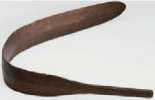
Figure 9

Figure 10
Also a sword of copper-arsenic alloy with a length of 47 cm was found in the Maikop barrow. It has a flared blade, a semi-circular tip and two rivets of silver on the tang. Elsewhere it is referred to as a dagger due to a different length (apparently in the folded state) of 34.7 cm (Figure 10). Nine cast double-edged swords (radiocarbon-dated 3095–2905 Cal BC) with an average length of 50 cm (from 45.9 cm to 62 cm) and an average weight of 521.5 g (from 410 g to 960 g) made of copper alloy with 3-6% arsenic with flat hilts (three of them with silver inlays) were found in the South-East Anatolia in the Taurus mountains in room III in building A113 ("hall of arms") in the palace-temple complex of Arslantepe (phase VIA, Late Uruk, final of the late Chalcolithic, around 3300–3000 BCE) near present-day Malatya in Turkey. They have a kind of ‗knuckle guard‘ curved in the direction of the hilt with semicircular top. The thickness of the hilt is almost identical to the thickness of the blade (Figure 11).
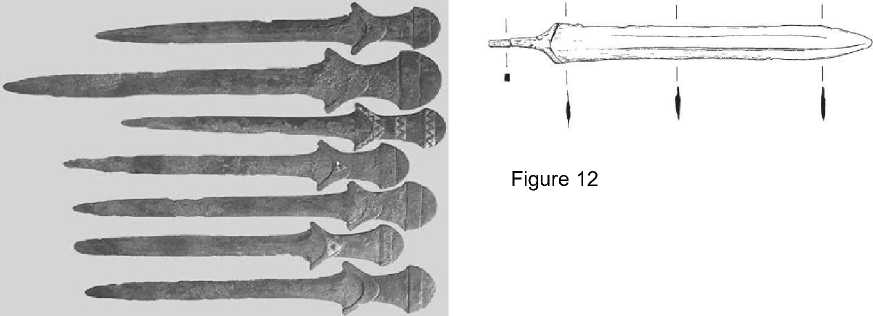
Figure 11
One more cast double-edged sword (radiocarbon dated 3085–2900 Cal BC) made of the alloy of copper and arsenic was found in the Royal tomb in the layer of the early bronze age Phase VIB1 (3000– 2900 BC) in the same Arslantepe. It has a tang without a knuckle-guard and without a bump‘ at the end (Figure 12).
In 1996, the Museum of Tokat (Turkey) has acquired a double-edged sword cast of alloy of copper and arsenic (inv. nom. 044/87, collection of Necdet Dilek) with a length of 44.1 cm and weighing 411.5 g with a knuckle-guard and a tang with a top. It has traces of blows on the blade. According to archeometrical analysis, it belongs to the group of blades of Arslantepe (Figure 13).

Figure 13
Figure 14
A sword made of alloy of copper (96%) with arsenic (2.11%) and nickel (0.70%) was found in Tülintepe 80 km North-East of Arslantepe. It dates back to 3400–2900 BC. Its length is 44.6 cm and its weight is 324 g. It has shoulders, a broken tip and a tang (Figure 14). Two swords of machete or cleaver type made of copper-arsenic-nickel alloy dating around 3000 BC (between 3200–2750 BC) were found as a part of Kfar Monash hoard (near a settlement 5 km East of the Mediterranean coast, 3.3 km South-East of Tell Hefer (Tell Ibshar) on the Sharon plain or 9 km North-East of Netanya, 32 km from Tel Aviv, 68 km from Jerusalem, Israel). Their total length is about 60 cm. They have blades expanding upwards, curved and rounded at the end 31 and 32 cm long (tangs are 30 and 22 cm long respectively). Their tangs are flat. The second cleaver has also an additional twisted tang 7 cm long. Both swords have only concave surface of the blade sharpened (Figure 15).

Figure 15
Figure 16
Three double-edged swords cast in bronze from Central Anatolia from Tombs A1, K and S of Alaca-hüyük date back to the second – third quarter of the III Millennium BC (Figure 16). They have a flattened blade lenticular in cross-section without a middle rib. The length of the largest, fragmented sword from the Tomb A1 with a long tang with a rivet hole at the end is 82.4 cm, the length of a highly fragmented sword with a broken tang from Tomb K is 61.6 cm, the length of the sword with a tang from the Tomb S is 53.5 cm.
A bronze sickle-sword from Susa (2500–2400 BC, A. Massafra) 37 cm long has two curls‘ (volutes) at the place of the lower bend of the blade and at its upper end, only the projecting part of the blade is sharpened; the sword has a tang with three holes for rivets (Figure 17).

Figure 17 Figure 19
A double-edged sword 59 cm long without a tang but with a middle rib on the blade from Amorgos (Cyclades) has no exact dating (Figure 18). This sword is kept in the Copenhagen Museum (inv.num. 3136) and has a long and thin blade with rounded shoulders with a rivet hole at the base of the blade on each side. The second sword 68.5 cm long from Amorgos is also kept in the Copenhagen Museum (inv.num. 3164) and has no exact dating. It is broken into three fragments and has no tip, the blade is severely damaged on both sides but has a middle rib, shoulders are almost lost, the tang is broken off. The early bronze age of the Cyclades dates back to 2500–2100 BC. There are three shorter and heavily damaged swords from Amorgos. The first one is 33.2 cm long with a middle rib and one preserved hole for riveting. The second is in the form of two fragments with a longitudinal rib of rigidity and has preserved a length of 36 cm. The third blade consists of two fragments with a middle rib and has preserved a length of 25.6 cm.
A fragmented piece of bronze sword 45 cm long with a middle rib from Levkas in the Ionian sea (Steno necropolis, Tomb Nidhri R7) dates back to III Millennium BC.
The (digital) collection of the British Museum contains (a photograph of) a sword dating back to 2400– 2000 BC with a total length of 106.5 cm made of copper-arsenic alloy (Museum number 127137), originating from Beth Dagan (Palestine) (Figure 19). This sword has a clearly expressed middle rib going from the pointed tip of the blade (rhombic in the cross section) to the end of the elongated trapezoidal tang tapering from the blade to the opposite side. The blade has barely outlined shoulders and two rows of holes for rivets made along both sides of the tang. Initially, the tang of the sword 12 cm long had 12 holes for rivets — 6 on each side. Similar (short) swords from Canaan dating back to the late III Millennium BC are made of copperarsenic alloy. They also have a middle rib running from the tip of the blade (rhombic in the cross-section) to the end of the tang (with holes for rivets on both sides of the shoulders and the tang). In particular, two short swords 40.4 cm (Figure 20) and 42.7 cm (Figure 21) long come from Tell el-Ajjul (neighborhood of Gaza, Palestine). Several bigger swords of this type 59.2 cm (Figure 22), 57.8 cm (Figure 23), 47 cm (Figure 24) and 42.8 cm (Figure 25) long respectively are not tied to a particular location.
Figure 21
Figure 20


The Akkadian rock crystal seal in the Louvre dating back to 2350–2200 BC (AO25305) depicts a duel of the Scorpion God armed with a long dagger or a short sword with an opponent whose hand is holding a sword.
This is identified by comparing the length of the blade of the weapon with the length of his half-bent arm from the elbow to the fist clenching the hilt. The blade of the sword is clearly longer. The blade of this sword is shown triangular and with a sharp tip (Figure 26).

Figure 27
Figure 28
Figure 26
The Metropolitan Museum, New York has a (digital) collection of (the photographs of) three bronze swords and two bronze daggers from Anatolia dating back to about 2300–2000 BC (final early bronze age in the chronology of Central Anatolia). These blades are similar to the daggers from Horoztepe (central part of Northern Anatolia, East of Amasya province, South of the town of Erba, Tokat province, Turkey, 2300–2000 BC). These are double-edged swords, with shoulders, a middle rib and a blade with a pointed tip. The first sword 49.50 cm long has a longitudinal rib of rigidity going from the tip of the blade to the end of the broken tang with traces of two holes for rivets (Figure 27). The second sword 43.79 cm long has a blade with a flattened middle rib tapering from the tang to the tip; the tang has a trace of one rivet hole at the end (Figure 28). The third sword 34.29 cm long has a middle rib going from the tip of the blade to the end of the tang with one rivet hole (Figure 29).

Figure 30
A sword and a part of a sword‘s blade cast in bronze from Mari on the Euphrates (East Syria) kept in the Louvre (AO18428; AO18441) date back to the III Millennium BC (more precise dating and the parameters are not listed) (Figure 30). The sword has shoulders, a tang and a broken tip.
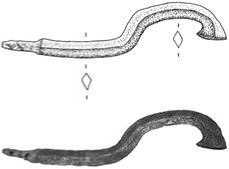
Figure 31
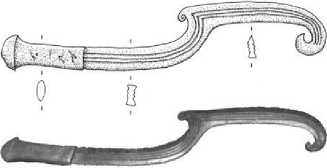
Figure 32
According to G. Gernez the sickle-swords from Tello (Sumer) and Susa (Elam) date back to the turn of III–II Millennia BC or to the end of the III thousand BC. Two short sickle-swords made of copper were discovered in burial 8 in Tell Tello (the Sumerian city of Girsu, in the province of Dhi Qar, Iraq, southern Mesopotamia). The first sword now kept in the Louvre (inv.number AO4355) (Figure 31) has a length of 27 cm, a middle rib, a double-edged blade diamond-shaped in cross-section with a tip bent downwards and a tang with two rivets. H. W. Müller dates it to the period between 2400 and 2000 BC. The second sword now kept in the Louvre (inv.number AO4354) (Figure 32) 41 cm long has a more complex blade with a triple groove running along it. The blade has a directed down process‘ at the place of the lower bend, and the upper end is curled‘ inside and down in the form of a volute. A lenticular hilt made of copper with a coneshaped knob is attached with two rivets. Only the projecting part of the blade is sharpened. A. Massafra dates the short sickle-sword from Girsu around 2400 BC, and longer one — by the XVIIth century BC. According to M. B. Rysin from Central and Eastern Anatolia straight double-edged swords and narrow swords of rapier type penetrated into the territory of Trialeti archaeological culture of the Transcaucasian middle bronze age dated by traditional methods around 2200–1800 BC, and by radiocarbon — 2200–1600 BC (Figure 33).

Figure 33
Figure 34
Different swords were found in the archaeological culture (2300–1700 BC).
South of Central Asia in the area of Bactrian-Margian
Two so-called ‗harpoons‘ which were found in the cyst (burial №3130) in the cemetery on the bank of the big southern basin of Northern Gonur (Turkmenistan, Margiana) date back to the end of III – the beginning of II thousand BC (Figure 34). The first is 49 cm long and has a silver hilt. The second is 65 cm and has a sharp tip and a tang. According to G. Gernez these ‗harpoons‘ are in fact specific type of a sicklesword. He mentions the discovery of three sickle-swords in Gonur Depe in graves 3230 and 3280. Two have blades rounded at the end and partially preserved hilts (Figure 35). The third has an angular blade pointed at the end. The blade is decorated with longitudinal grooves. They date back to 2100–1800 BC.

Figure 35
Figure 36
-
A. Massafra reports on three sickle-swords from Bactria of the Namazga IV period (2250–1800 BC) (Figure 36). The first sword is 50.2 cm long (Louvre, inv.number AO26438). It is cast in copper with tin (2.2%), arsenic (2.2%) and lead (1.1%). It has a blade expanding upward, especially after bending, with a sharp downward protrusion at the upper end. The blade is decorated with four grooves along its entire length. It also has asymmetrical, sloping shoulders and a long tang tapering to the end. The second sword 50 cm long (Louvre) of arsenical copper has a narrow blade without middle ribs. It is strongly curved at the top, has one sloping shoulder opposite the bending side, and a tapering tang. The third sword 42 cm long (Louvre) from arsenic copper with a partially lost tang has a simple blade extending from the tang to a smooth bend. The blade is without middle ribs, shoulders are absent at all.
A double-edged sword 52 cm long with shoulders and a tang with a short antenna‘ at the end was found in Bactria (Northern Afghanistan) (Figure 37). This weapon belongs typically to the blades of the Copper Hoards or Ochre Coloured Potter culture and can be dated circa 2000 BC or later.

Figure 37
V. CONCLUSION
Rigveda and Atharvaveda Shaunaka Samhitas have been carefully analyzed to check whether they mention copper or bronze swords. It has turned out that both texts do not know swords (only knives) and therefore must be dated in their habitats in the Northwest of the Indian subcontinent prior to the introduction of such weapons into the region. Swords have been archaeologically evidenced both in the Indus valley and in the Yamuna–Ganges Doab only after 2000 BC. This facts make us date Atharvaveda Shaunaka prior to 2000 BC, and more archaic Rigveda — a few centuries earlier (prior to 2600 BC).
Then all available data on copper and bronze swords of different types (straight double-edged, machete-cleaver, sickle-shaped, rapier‘, harpoon‘) originating from the Old World and dating back to 3500– 2000 BC have been collected and scrutinized.
Based on this analysis the following regions are to be excluded from the list of possible Indo-Aryan homelands prior to 2000 BC because they already had copper or bronze swords: North-Western Caucasus, Kuban region — in 3500–3300 BC; (South-) East Anatolia – in 3400–2900 BC; Palestine/ Israel/ Canaan — in 3200–2750 BC, 2400–2000 BC; Central Anatolia – in 2750–2250 BC; Elam — in 2500–2000 BC; Cyclades
— in 2500–2100 BC; Mesopotamia, Sumer – in 2400–2000 BC; Mesopotamia, Akkad — in 2350–2200 BC; Northern Anatolia – in 2300–2000 BC; Bactria–Margiana — in 2300–2000 BC; Transcaucasia — in 2200– 2000 BC.

